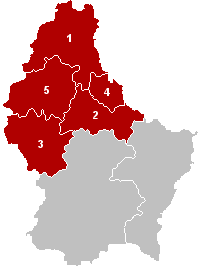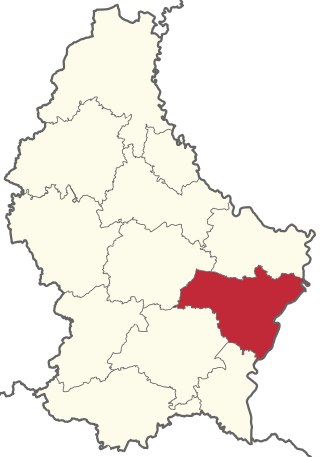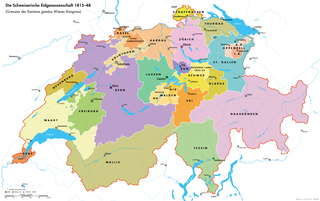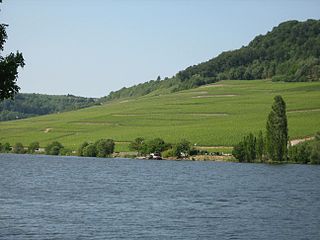
The three districts of Luxembourg were the top-level administrative divisions of the Grand Duchy of Luxembourg. The districts were further subdivided into cantons, which still exist:

The District of Diekirch was one of three districts of the Grand Duchy of Luxembourg. Immediately prior to its abolition on 3 October 2015, it contained five cantons divided into 43 communes:
- Clervaux
- Diekirch
- Redange
- Vianden
- Wiltz

The rise of Switzerland as a federal state began on 12 September 1848, with the creation of a federal constitution in response to a 27-day civil war, the Sonderbundskrieg. The constitution, which was heavily influenced by the United States Constitution and the ideas of the French Revolution, was modified several times during the following decades and wholly replaced in 1999. The 1848 constitution represented the first time, other than when the short-lived Helvetic Republic had been imposed, that the Swiss had a central government instead of being simply a collection of autonomous cantons bound by treaties.

Forêts[fɔ.ʁɛ] was a department of the French First Republic, and later the First French Empire, in present-day Belgium, Luxembourg, and Germany. Its name, meaning 'forests', comes from the Ardennes forests. It was formed on 24 October 1795, after the Austrian Netherlands had been annexed by France on 1 October. Before annexation, the territory was part of the Duchy of Luxembourg and little parts of the Duchy of Bouillon. Its capital was Luxembourg City.
The 12 cantons of the Grand Duchy of Luxembourg are areas of local government at the first level of local administrative unit (LAU-1) in the European Union's Nomenclature of Territorial Units for Statistics for Eurostat purposes. They were subdivisions of the three districts of Luxembourg until 2015, when the district level of government was abolished. The cantons are in turn subdivided into 102 communes.

Grevenmacher is a canton in the east of Luxembourg. Its capital is Grevenmacher, a commune with town status. The canton's name derives from its principal municipality. Neither the canton, town, or commune of Grevenmacher should be confused with the former district of Grevenmacher, one of three administrative units in Luxembourg abolished in October 2015.

The Federal Assembly, also known as the Swiss parliament, is Switzerland's federal legislature. It meets in Bern in the Federal Palace.

Grevenmacher is a commune with town status in eastern Luxembourg, near the border with Germany. It gives its name to and is the capital of the canton of Grevenmacher, and, until its abolition in 2015, the district of Grevenmacher. The town is situated on the left bank of the river Moselle, in a wine growing region.
The Swiss Confederation comprises the 26 cantons of Switzerland.
Voting in Switzerland is the process by which Swiss citizens make decisions about governance and elect officials. The history of voting rights in Switzerland mirrors the complexity of the nation itself. The polling stations are opened on Saturdays and Sunday mornings but most people vote by post in advance. At noon on Sunday, voting ends and the results are usually known during the afternoon.

The periods of Restoration and Regeneration in Swiss history lasted from 1814 to 1847. "Restoration" is the period of 1814 to 1830, the restoration of the Ancien Régime (federalism), reverting the changes imposed by Napoleon Bonaparte on the centralist Helvetic Republic from 1798 and the partial reversion to the old system with the Act of Mediation of 1803. "Regeneration" is the period of 1830 to 1848, when in the wake of the July Revolution the "restored" Ancien Régime was countered by the liberal movement. In the Protestant cantons, the rural population enforced liberal cantonal constitutions, partly in armed marches on the cities. This resulted in a conservative backlash in the Catholic cantons in the 1830s, raising the conflict to the point of civil war by 1847.

The Moselle Valley is a region in north-eastern France, south-western Germany, and eastern Luxembourg, centred on the river valley formed by the river Moselle. The Moselle runs through, and along the borders of, the three countries, and drains a fourth, Belgium.

Constituencies are used to elect representatives ('deputies') to Luxembourg's unicameral national legislature, the Chamber of Deputies.
In Germany and Switzerland, a Landeskirche is the church of a region. The term usually refers to Protestant churches, but—in case of Switzerland—also Roman Catholic dioceses. They originated as the national churches of the independent states, States of Germany (Länder) or Cantons of Switzerland , that later unified to form modern Germany or modern Switzerland, respectively.
François Altwies was a Luxembourgian politician. He sat in the Chamber of Deputies, of which he served as President from 1917 until 1925.

Charles Gérard Emmanuel Metz was a Luxembourgian politician, journalist, and lawyer. He was a prominent pro-Belgian in the Belgian Revolution, serving in the Belgian national legislature, before entering the Chamber of Deputies of Luxembourg, of which he was the first President, from 1848 to 1853.
Pierre-Ernest Dams was a Luxembourgish politician, judge, and journalist. He was a major figure in the formative years of Luxembourg as an independent country.
The constituency Esch-sur-Alzette elected members to Luxembourg's national legislature, the Chamber of Deputies, from 1848 until its abolition in 1919. It was coterminous with the canton of Esch-sur-Alzette, in the south of the country.

Federal elections were held in Switzerland on 25 October 1863. The Radical Left remained the largest group in the National Council, but lost its majority for the first time since 1848.

Federal elections were held in Switzerland on 27 October 1872. The Radical Left remained the largest group in the National Council.











